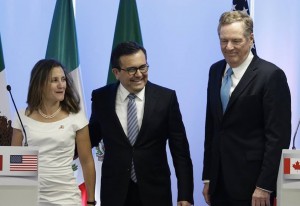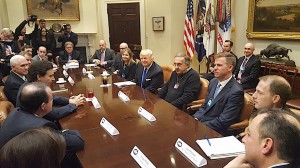
Trade representatives from Canada, Mexico and the U.S. continue negotiating a revised NAFTA agreement.
The latest proposals from the U.S. in the ongoing North American Free Trade Agreement talks have been met with tepid curiosity and outright defiance from Mexico’s delegation.
The U.S. proposal, according to Reuters, increases NAFTA’s regional automotive content and would carry a four-year phase-in to meet a higher, 75% regional value threshold. The current level is 62.5% while new labor content rules requiring substantial work at wages of $16 an hour or higher.
The new deal would require the $16 wage on work comprising 40% of the value of light-duty passenger vehicles and 45% for pickup trucks. Mexico, where salaries average less than $6 per hour at automakers, wasn’t keen on the new idea.
The U.S. proposal “is not acceptable. The percentage, the transitions, the restrictions,” Mexican Auto Industry Association president Eduardo Solis told Reuters.
(New roadblocks thrown up in NAFTA negotiations. Click Here for the story.)
The U.S. plan would allow automakers to count the high salaries paid for engineering, research, sales, software and product development jobs towards 15 percentage points of these goals, a provision that benefits Detroit automakers and disadvantages foreign brands that do such work outside the United States.
The three countries have been working diligently, but slowly toward a renegotiated deal; however, President Donald Trump has pushed for certain provisions, such as the increased U.S. and North American content levels, despite getting pushback from Mexico and Canada, as well as U.S. automakers and other manufacturers.
Certain “high value” parts such as engines and drivetrains would also have to meet the 75% threshold, and auto manufacturers would need to purchase 70% of the steel and aluminum from North America. Lesser parts would be subject to the same regional value threshold they currently have.
(Click Here for more about NAFTA talks likely to resume in May.)
The new levels have auto groups expressing concern but also offering encouragement to the Trump administration to find a good balance.
“Alliance members support the Administration’s goal of growing U.S. auto manufacturing and jobs,” noted the Auto Alliance in statement. “However, there is a delicate balance that must be struck with auto rules of origin – one that continues to incentivize production in North America versus forgoing the NAFTA benefits and moving production to other low-cost production regions.
“The Alliance is concerned that the draft currently being discussed may not achieve the Administration’s goal, and urges the Administration to ensure that a modernized NAFTA continues to strike the right balance.”
(To see more about Trump reversing his stance on the Trans Pacific Partnership, Click Here.)
There also concern about the length of time for the transition — just four years. The initial NAFTA allowed nine years to get to 62.5%. “We continue to be concerned about the phase-in time and the amount of paperwork that will be necessary for compliance,” said Ann Wilson, senior vice president of government affairs for the Motor and Equipment Manufacturers Association.

